Laplace no Ma (ラプラスの魔), released 7/14/1995, published by Vic Tokai
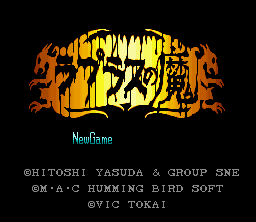
The title of this game means “Laplace’s Demon,” and is a reference to a thought argument against free will in a deterministic universe. I’m not sure if this has anything to do with the game, though. The game was initially released for several Japanese computers in 1987. The original game was a first-person blobber dungeon explorer game. The Japanese sites I can find about it say that it was extremely difficult and some people even consider it a kusoge, although when you think about the kind of RPGs that were coming out in 1987, this may not be a surprise.
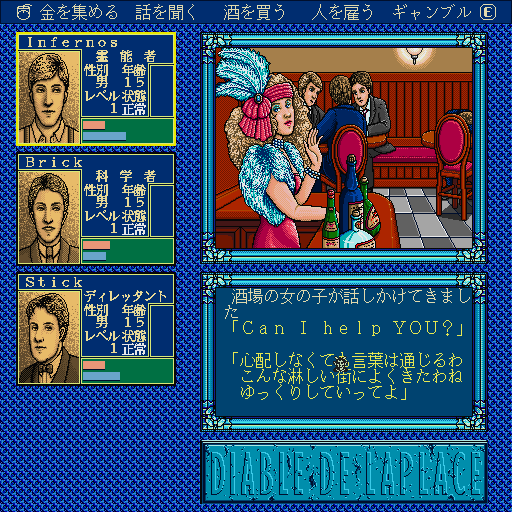
In 1993 it was ported to PC Engine; it seems to be mostly a direct port although I did see a Japanese site saying that it was easier and that it lost some of the original atmosphere of the game. Finally in 1995, eight years after its initial release, it was ported to the Super Famicom. This version changed from the first-person style to a top-down JRPG style. Since this is a port I only played the first of the three dungeons in the game. There is a translation patch for it if you want to try it out.
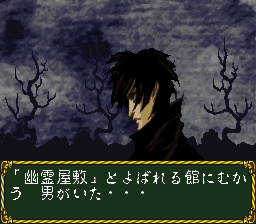
The game takes place in 1920s America, in an eastern rural town called Newkam (apparently named after Lovecraft’s Arkham). There’s an old mansion called the Weathertop Mansion that has all kinds of ghost stories associated with it, and the player characters have gathered in town to investigate. You start off by creating your main character.
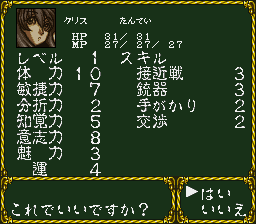
You choose a sex, name, and job. The jobs are basically the classes:
- Investigator (best at fighting)
- Journalist (can take pictures of enemies to sell for money, this is the main way to get money in the game)
- Scientist (can make various machines to attack with)
- Spiritualist (casts spells)
- Dilettante (kind of a mix of journalist and spiritualist, but learns magic from books)
The abilities are on the left, which include some standard ones, but others I wasn’t sure of the use for. The right is Skills which can be improved at the library by spending experience. The skills are:
- Hand-to-hand combat
- First Aid (helps with using heal items)
- Search (I was never sure what this did; a page says that if your search is low you can’t always get items or might break them, but I never saw this happen)
- Magic (for the dilettante)
- Machine (for the Scientist)
- Gun
- Mental healing (helps with using MP restore items)
- Negotiation (helps with gaining information, but I wasn’t sure exactly how this worked)
- Spiritualism (for the spiritualist)
- Photography for the journalist)
Once you create your person, you go to the bar and find the NPCs you want to join your party. I took a journalist, a dilettante, and a scientist.
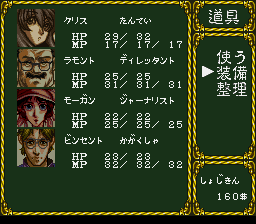
They start with equipment so it’s not necessary to buy that; I was never quite sure what the weapons did in the shop since there’s no real explanation (probably that’s in the instruction manual). I stocked up on bullets, and film for the photographer and batteries for the scientist’s machines. I also got some requests to find out what happened to other people who went to the mansion.
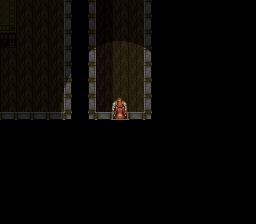
Finally I headed into the mansion. From what I can see on web pages, the dungeons in this game are based on those of the original game but are generally larger.
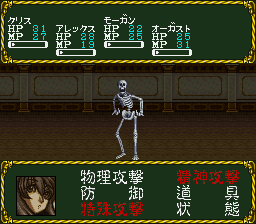
There are random encounters. The battle system is standard although the machines and spells do give you some variety. The arrow under each character advances during the battle and unlocks a special attack once it fills up.
The biggest problem with the battles, and probably the largest flaw in the game, is that they give so little XP that they’re barely worth fighting, especially given how nasty some of the monsters can be. You get so much XP from fulfilling the town requests and other story things that you really can run from every fight and still advance quite a bit, and since there really aren’t important equipment upgrades in town, you can refill your stocks of healing and other items just by taking a bunch of pictures.
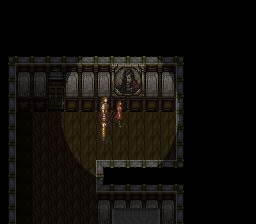
The mansion, on the other hand, is well designed. Almost every room has some kind of description and character to it, and you can find a lot of hidden items as well as monsters and story lore in the rooms. There are a lot of puzzles you have to solve to move forward in the game.
The story of this first part of the game is basically that Benedict, the owner of the mansion, became erratic and strange after his mother’s death, and began to dabble in magic. He was hoping to revive his mother but instead got involved in stuff he wasn’t expecting, and the house became overrun with monsters. Eventually we are able to ring a bell in the mansion and stop the monsters in there, but we then have to go through a portal to Laplace Castle to stop the true evil.
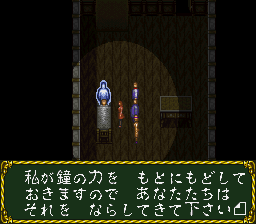
This game does not have a good reputation among Japanese players, but it was hard for me to determine why. I thought that maybe players were comparing it unfavorably to the original PC game, but that doesn’t seem to have a great reputation either.
It definitely has a good setting and story, and some of the system innovations are interesting. For me the biggest problem, as I said above, is that there’s almost no purpose in fighting the monsters. Given this, I think I would have enjoyed the game a lot more if there were no random encounters, only fixed ones (perhaps with some places where you could fight a fixed encounter multiple times). Having the exploration constantly interrupted by pointless encounters really hurt the immersion for me.
> This game does not have a good reputation among Japanese players, but it was hard for me to determine why. I thought that maybe players were comparing it unfavorably to the original PC game, but that doesn’t seem to have a great reputation either.
Huh! That’s interesting. What kind of things are they saying?
I think maybe just the creakiness of a 1987 game was offputting — it sounds like the biggest problem was just the game balance; it was too difficult.
Seems kind of weird to me that a kusoge would get ported to so many systems, aren’t those usually one system affairs?
Still, nice to see it isn’t such a bad game. I remember someone mentioning it in relation to Legacy – Realm of Terror, since both are horror RPGs centered around a haunted mansion. They sound like they’re roughly the same, interesting ideas, but not so good execution.
The ports are all easier than the original. I did some more digging after writing the post and it seems like whether you liked the original computer game or not depends on how well you can deal with things that were common for late 1980s computer RPGs — no automap, unbalanced combat, and head-scratching puzzles. It seems like people consider it a pretty good RPG for the time it came out, but it just hasn’t aged well.
It is “Photography for the journalist)”
You forgot the “(” between Photography and for
Looks a interesting game with a setting that is quite rare for JRPG.
The release on snes was supposed to come out in 1993, but they delayed the release by two years. The game was different, here is a preview for 1993
https://archive.org/details/weekly-famitsu-no.-235-june-18th-1993/page/18/mode/1up?view=theater
Interesting, so the original concept was that this would also be first person blobber style like the original. I wonder what happened in the development?